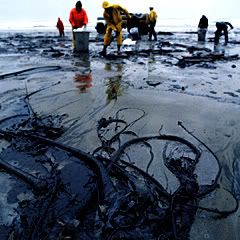The perils of offshore oil drilling
 President Bush echoed the call of Republican presidential candidate John McCain this week in calling for an end to the 27-year-old federal ban on offshore oil drilling along the East and West coasts and in the eastern Gulf of Mexico. The proposal comes amid soaring gas prices and rising levels of consumer anxiety, with drilling proponents making the case for increasing domestic supplies -- even though the American Petroleum Institute says opening U.S. coastal waters to drilling won't provide Americans with more oil for at least seven to 10 years.
President Bush echoed the call of Republican presidential candidate John McCain this week in calling for an end to the 27-year-old federal ban on offshore oil drilling along the East and West coasts and in the eastern Gulf of Mexico. The proposal comes amid soaring gas prices and rising levels of consumer anxiety, with drilling proponents making the case for increasing domestic supplies -- even though the American Petroleum Institute says opening U.S. coastal waters to drilling won't provide Americans with more oil for at least seven to 10 years.
McCain's call prompted his friend Florida Gov. Charlie Crist to reverse his longtime support for the drilling moratorium, which Crist now says is a states' rights issue. Elsewhere in the South, Virginia, Mississippi and South Carolina support lifting the moratorium, while North Carolina remains opposed.
Crist is not the only Florida leader to change his stance on the contentious issue. U.S. Sen. Mel Martinez said he would now consider drilling as long as it was at least 50 miles off the coast. And Florida state Sen. Burt Saunders, chair of the Environmental Preservation and Conservation Committee, told the New York Times that he began changing his mind on the issue after Hurricane Katrina, when no major spills from offshore drilling operations reached the coast.
But as the paper noted, Saunders neglected to mention that the back-to-back wallops of Katrina and Hurricane Rita caused 124 spills that released more than 700,000 gallons of petroleum pollution into the environment.
Furthermore, the problem of drilling-related pollution is not limited to the aftermath of natural disasters. Offshore oil production also brings with it the risk of spills from tanker accidents, which are devastating to ocean and shore life as well as seaside tourist economies. Then there's the chronic pollution from drilling operations. The Rainforest Action Network estimates that over its lifetime one normally operating oil drilling rig will:
* dump more than 90,000 metric tons of toxic drilling fluid and metal cuttings into the ocean;
* drill between 50 and 100 wells, each of which will dump as much as 25,000 pounds of toxic metals including lead, chromium and mercury, and potent carcinogens like toluene, benzene, and xylene into the ocean; and
* pollute the air as much as 7,000 cars driving 50 miles a day.
(Photo of a beach after an offshore oil spill courtesy of the National Oceanic and Atmospheric Administration)
Tags
Sue Sturgis
Sue is the former editorial director of Facing South and the Institute for Southern Studies.
